Up To $2,500 OFF at checkout - Ends Dec 12
Free 30-day Returns | Lifetime Warranty
What Is Diamond Clarity?

Explore diamond clarity grade and how it will influence the overall appearance of your diamond engagement ring.
1. Introduction
When choosing an engagement ring, diamond clarity might stand low on your list of priorities because it is common to focus on the carat size and cut.
However, remember that diamonds are evaluated based on 4 Cs: carat, cut, color, and clarity. Although it can seem confusing, understanding 4 Cs diamond clarity can help you find the perfect diamond while potentially saving you a significant amount of money.
This article will explore diamond clarity grades, the types of inclusions, and how understanding them can help you get the most beautiful diamond for your budget.
2. What is diamond clarity?
2.1. Definition
Clarity is the absence of internal inclusions and surface blemishes on a diamond. It is one of the four factors that describe and determine a diamond's quality and value. The fewer inclusions and blemishes a diamond has, the higher grade it will receive on the diamond clarity chart.

Diamond clarity
Diamonds with inclusions or blemishes that aren't visible to the naked eye are called 'eye clean.' If you’re looking for a high-clarity diamond, ensuring it is eye-clean is the most important factor.
2.2. Why does clarity matter?
Clarity is incredibly important in determining a diamond's overall appearance, quality, and price.
- Appearance: Heavily included diamonds may appear duller and not shine as brightly as those with a better quality grade.
- Quality: A diamond with too many inclusions may be less durable and prone to chipping.
- Price: Flawless and Internally Flawless diamonds are incredibly rare and expensive. Eye-clean or Slightly Included (SI) diamonds are much more accessible.
Multiple inclusions in a diamond with a lower clarity grade directly impact its sparkle. These inclusions obstruct how light enters and reflects within the diamond, resulting in a cloudy or less brilliant appearance.
3. The diamond clarity grading scale
The Gemological Institute of America (GIA) has established an 11-grade diamond clarity chart that is widely used in the diamond industry since 1953. This scale helps standardize clarity evaluation and ensures that buyers know exactly what they are purchasing.
Here’s a quick breakdown of the grades:

Flawless (FL):
- No inclusions or blemishes are visible under 10x magnification, eye clean.
- Extremely rare and valuable.
Internally Flawless (IF):
- No internal inclusions are present, although minor surface blemishes may exist
- Eye clean
Very Very Slightly Included (VVS1 and VVS2):
- Extremely difficult to see under 10x magnification, eye-clean
- Eye clean
Very Slightly Included (VS1 and VS2):
- Inclusions are present but are minor and only detectable under magnification
- Generally eye-clean.
Slightly Included (SI1 and SI2):
- Inclusions become more noticeable under magnification
- Might be detectable to the unaided, untrained eye.
Included (I1, I2, and I3):
- These diamonds contain obvious inclusions to the unaided, untrained eye
- Can affect the stone’s transparency and brilliance.

Flawless (FL):
- No inclusions or blemishes are visible under 10x magnification, eye clean.
- Extremely rare and valuable.
Internally Flawless (IF):
- No internal inclusions are present, although minor surface blemishes may exist
- Eye clean
Very Very Slightly Included (VVS1 and VVS2):
- Extremely difficult to see under 10x magnification, eye-clean
- Eye clean
Very Slightly Included (VS1 and VS2):
- Inclusions are present but are minor and only detectable under magnification
- Generally eye-clean.
Slightly Included (SI1 and SI2):
- Inclusions become more noticeable under magnification
- Might be detectable to the unaided, untrained eye.
Included (I1, I2, and I3):
- These diamonds contain obvious inclusions to the unaided, untrained eye
- Can affect the stone’s transparency and brilliance.
4. Types of inclusions and blemishes
The tiny imperfections and flaws present in diamonds are collectively referred to as "inclusions". However, there are various types of diamond inclusions, each resulting from different natural processes. Some are more prominent than others.
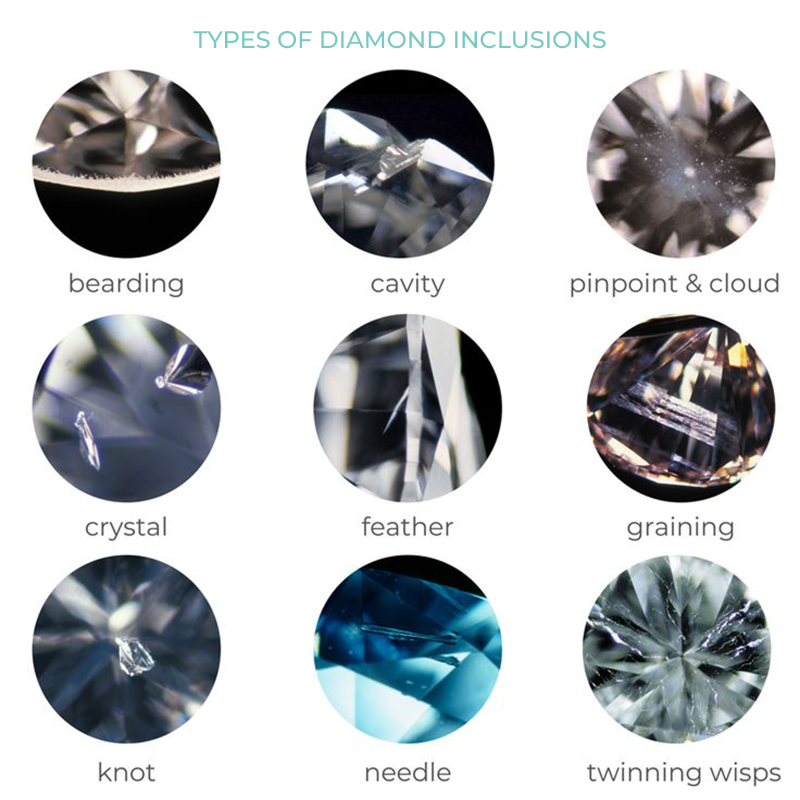
4.1. Common inclusions
- Crystal: a minuscule diamond (or other mineral) within the diamond; sometimes colored
- Pinpoints: tiny white or black crystals, appearing like a pinprick within the diamond
- Needle: an elongated, thin line of crystal
- Cavity or chip: usually caused by stressing a weak point during diamond cutting, a cavity in the surface
- Feathers: an internal crack or fissure, that appears light and feather-like, sometimes transparent without magnification
- Clouds: a cluster of pinpoint inclusions, which can make a diamond appear milky or hazy
- Knot: a small crystal that breaches the surface of the diamond, like a tiny bump on the surface
- Twinning wisps: veils of tiny needles, clouds, pinpoints and crystals running along the diamond's twinning plane, or caused by growth distortion

4.1. Common inclusions
- Crystal: a minuscule diamond (or other mineral) within the diamond; sometimes colored
- Pinpoints: tiny white or black crystals, appearing like a pinprick within the diamond
- Needle: an elongated, thin line of crystal
- Cavity or chip: usually caused by stressing a weak point during diamond cutting, a cavity in the surface
- Feathers: an internal crack or fissure, that appears light and feather-like, sometimes transparent without magnification
- Clouds: a cluster of pinpoint inclusions, which can make a diamond appear milky or hazy
- Knot: a small crystal that breaches the surface of the diamond, like a tiny bump on the surface
- Twinning wisps: veils of tiny needles, clouds, pinpoints and crystals running along the diamond's twinning plane, or caused by growth distortion
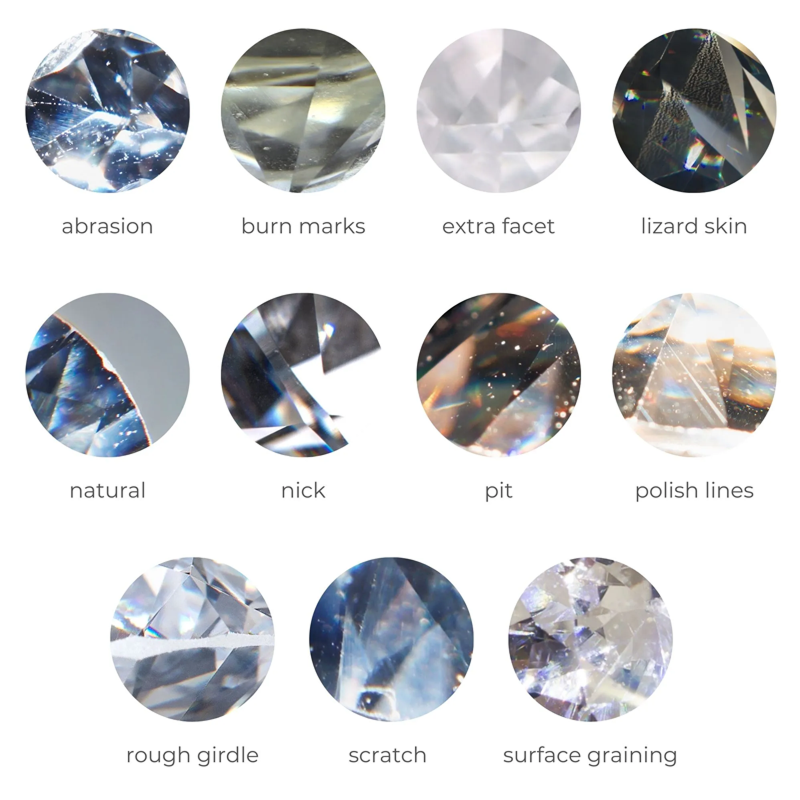
4.2. Common blemishes
- Abrasion: Tiny nicks along facet junctions, giving a milky, fuzzy look, usually from careless handling.
- Burn marks: Hazy spots from excessive polishing heat, removable without harming durability.
- Extra facet: An extra cut near the girdle to remove flaws, affecting symmetry but not clarity grading.
- Lizard skin: Wavy or bumpy texture from incorrect polishing, easily smoothed out.
- Scratches: Surface-level marks caused during handling or cutting.
- Natural: An unpolished portion of a rough diamond, usually near the girdle.
- Nick: A tiny chip on a facet junction, often from wear, which can weaken the diamond.
- Pit: A small white cavity on a polished diamond, caused by pinpoint removal during polishing.
- Polish lines: Thin parallel grooves on a facet, formed during polishing, either transparent or white.
- Rough girdle: An irregular or grainy girdle surface, often with bearding, indicating potential durability issues.

4.2. Common blemishes
- Abrasion: Tiny nicks along facet junctions, giving a milky, fuzzy look, usually from careless handling.
- Burn marks: Hazy spots from excessive polishing heat, removable without harming durability.
- Extra facet: An extra cut near the girdle to remove flaws, affecting symmetry but not clarity grading.
- Lizard skin: Wavy or bumpy texture from incorrect polishing, easily smoothed out.
- Scratches: Surface-level marks caused during handling or cutting.
- Natural: An unpolished portion of a rough diamond, usually near the girdle.
- Nick: A tiny chip on a facet junction, often from wear, which can weaken the diamond.
- Pit: A small white cavity on a polished diamond, caused by pinpoint removal during polishing.
- Polish lines: Thin parallel grooves on a facet, formed during polishing, either transparent or white.
- Rough girdle: An irregular or grainy girdle surface, often with bearding, indicating potential durability issues.
5. How to evaluate diamond clarity as a beginner
5.1. Tools for clarity assessment
Jeweler's loupe or microscope: These tools magnify the diamond, allowing you to see inclusions more clearly. A 10x magnification loupe is standard for diamond grading.
Certification from reputable labs: Certificates from labs like GIA (Gemological Institute of America) or AGS (American Gem Society) provide an independent assessment of a diamond's clarity grade, giving you confidence in your purchase.

KNT Jewelry’s Moissanite GRA certificate
5.2. Tips for choosing clarity diamond grades
- Balancing clarity and budget: Most buyers find the sweet spot with VS1, VS2, or SI1 clarity grades. These offer excellent value, as they are often eye-clean without the premium price of Flawless or Internally Flawless diamonds.
- Focus on eye-clean diamonds: The most important factor is whether the diamond is "eye-clean," meaning inclusions are not visible without magnification. Don't overspend on a higher diamond and clarity chart if the inclusions are not noticeable to the naked eye.
- Consider diamond size and shape: Larger diamonds tend to show inclusions more readily. Certain cuts, like emerald or Asscher, with their larger facets, also make inclusions more visible. If you're choosing a larger diamond or a step-cut, consider moving slightly higher in clarity.
6. Diamond clarity vs. other 4Cs
Clarity is one of the key factors when evaluating a diamond, but it doesn’t work in isolation. It interacts with the other 4Cs—cut, color, and carat weight—to determine the diamond’s overall beauty and value.
- Cut: Cut is arguably the most important factor in how a diamond looks. A well-cut diamond reflects light in the best way, creating sparkle and brilliance. In many cases, it can help compensate for lower clarity. For example, a diamond with a few minor inclusions might still appear stunning if it’s cut well, while a poorly cut diamond with perfect clarity might look dull and lifeless. Prioritizing a great cut over clarity is often a good trade-off for achieving more sparkle.
- Color: A diamond’s color is less noticeable in diamonds with high clarity, since inclusions or blemishes might distract from the overall appearance. However, in diamonds with lower clarity, the inclusions can sometimes be more noticeable, so choosing a higher color grade can help offset that. A clearer diamond will show off its true color, making the interaction between clarity and color especially important when you’re looking for a balanced stone.
- Carat: Carat weight is about size, but larger diamonds might have more visible inclusions simply because there’s more surface area to inspect. So, with larger diamonds, clarity becomes more significant. That said, if you’re prioritizing size, you might need to accept some inclusions, but balancing that with a great cut can make those imperfections less noticeable.
Ultimately, it’s all about finding the right balance for your preferences and budget. Each of the 4Cs plays a role in how the diamond looks, so you may need to make trade-offs depending on what’s most important to you.

Oval brilliant cut is designed to maximize the reflection of light
7. Clarity grades and price
7.1. How clarity affects diamond pricing
The two main factors influencing a diamond's price are its shape and carat weight, but clarity diamond also plays a significant role. Diamonds with higher 4 Cs diamond clarity generally cost more than those with lower grades of the same quality.
7.2. Finding the best value
There is no universally ‘right’ or ‘wrong’ clarity grade. We never recommend you drop the big bucks on a Flawless or Internally Flawless diamond, and we would never say that all SI2 or I1 diamonds are bad, either. The key is finding the sweet spot: an eye-clean diamond within your budget.
Smaller diamonds can hide inclusions better, so you can often go with a lower chart diamond clarity. For a one-carat diamond, VS2 and SI1 are good starting points. Larger diamonds might require VVS2 or VS1 for the same eye-clean look. The best approach is to carefully examine diamonds to find one that's beautiful, eye-clean, and fits your budget.
8. Common myths about diamond clarity
8.1. Myth: All inclusions are bad
The location of the inclusions, on and inside the diamond, is taken into consideration. Since diamonds are graded from top to bottom, an inclusion on the bottom is less likely to decrease the clarity grade.
8.2. Myth: Higher clarity always looks better
A frequent mistake when purchasing diamonds is prioritizing a top-tier clarity grade (FL, IF,...) and overspending. While these diamonds are indeed high quality, the visual difference between them and diamonds graded VVS1&VVS2 is often visually the same to the naked eye. Yet, the price difference can be substantial.
9. Conclusion
Keep in mind that diamond clarity is only one of the four key factors to evaluate before purchasing a diamond. You should also take into account the diamond's color, cut, carat weight, price, and other elements. Finding the right diamond is similar to solving a big jigsaw puzzle - only when all the pieces align will you discover the perfect diamond for you.
4 CS OF DIAMONDS
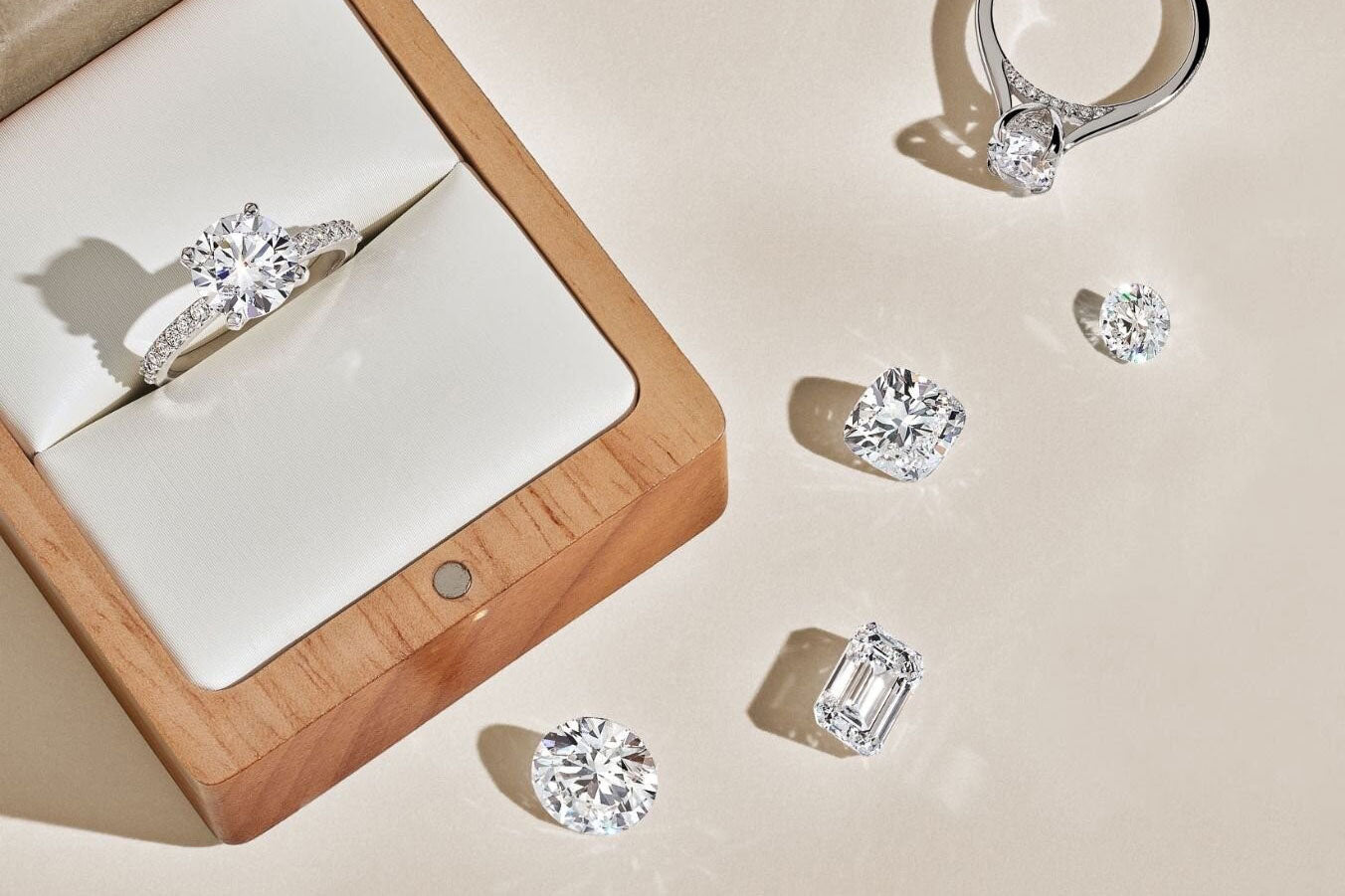
4 Cs of diamond quality
No two diamonds are identical. Each has distinct characteristics. To make an informed choice, focus on the 4 Cs: cut, color, clarity, and carat weight. These factors define a diamond’s brilliance, rarity, and value.
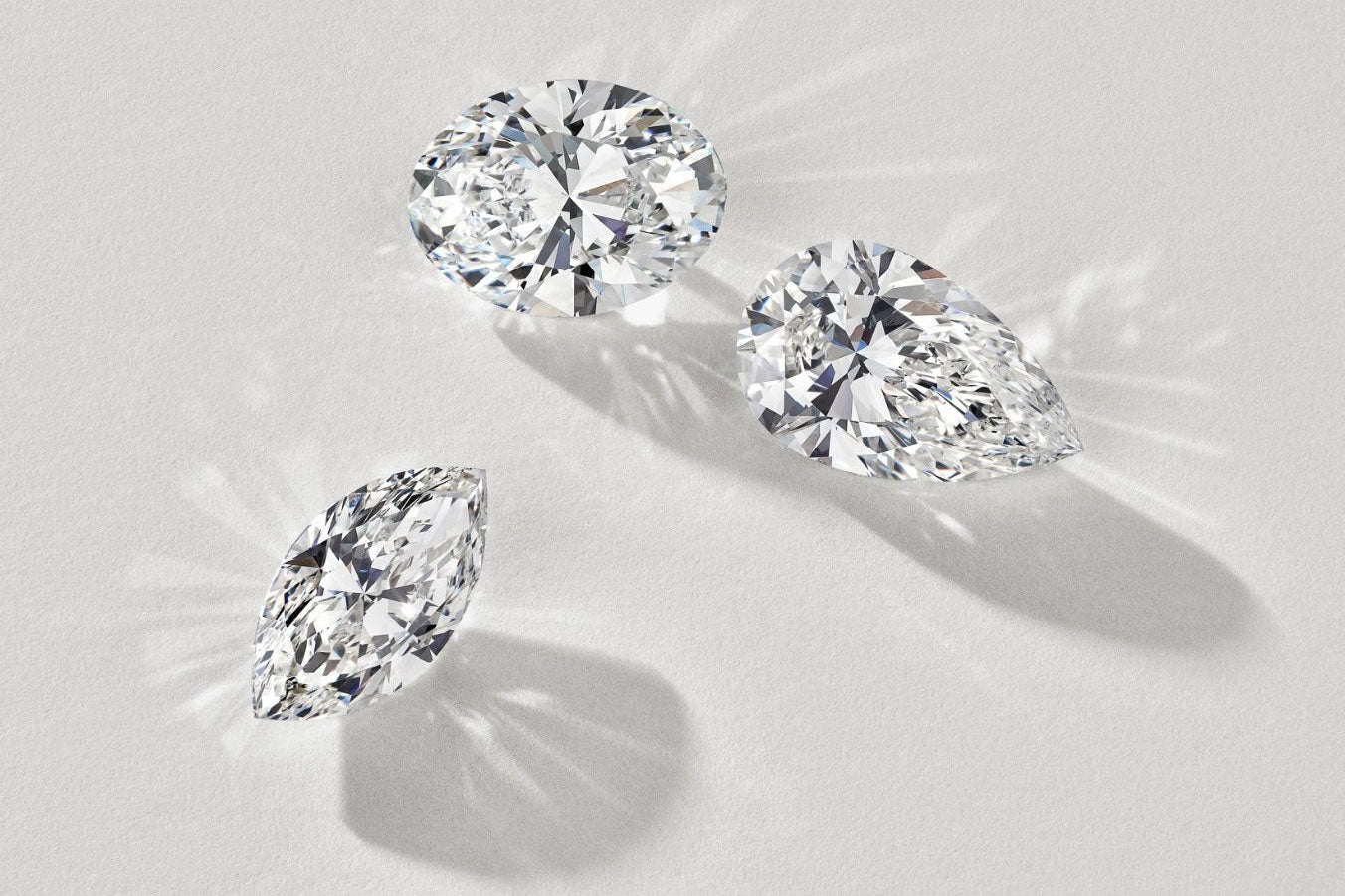
Diamond Cut
Diamond cut refers to the precision and quality of a diamond’s facets - the tiny, flat surfaces on its surface - and how they are shaped, proportioned, and polished. It is one of four key factors, known as the 4Cs.
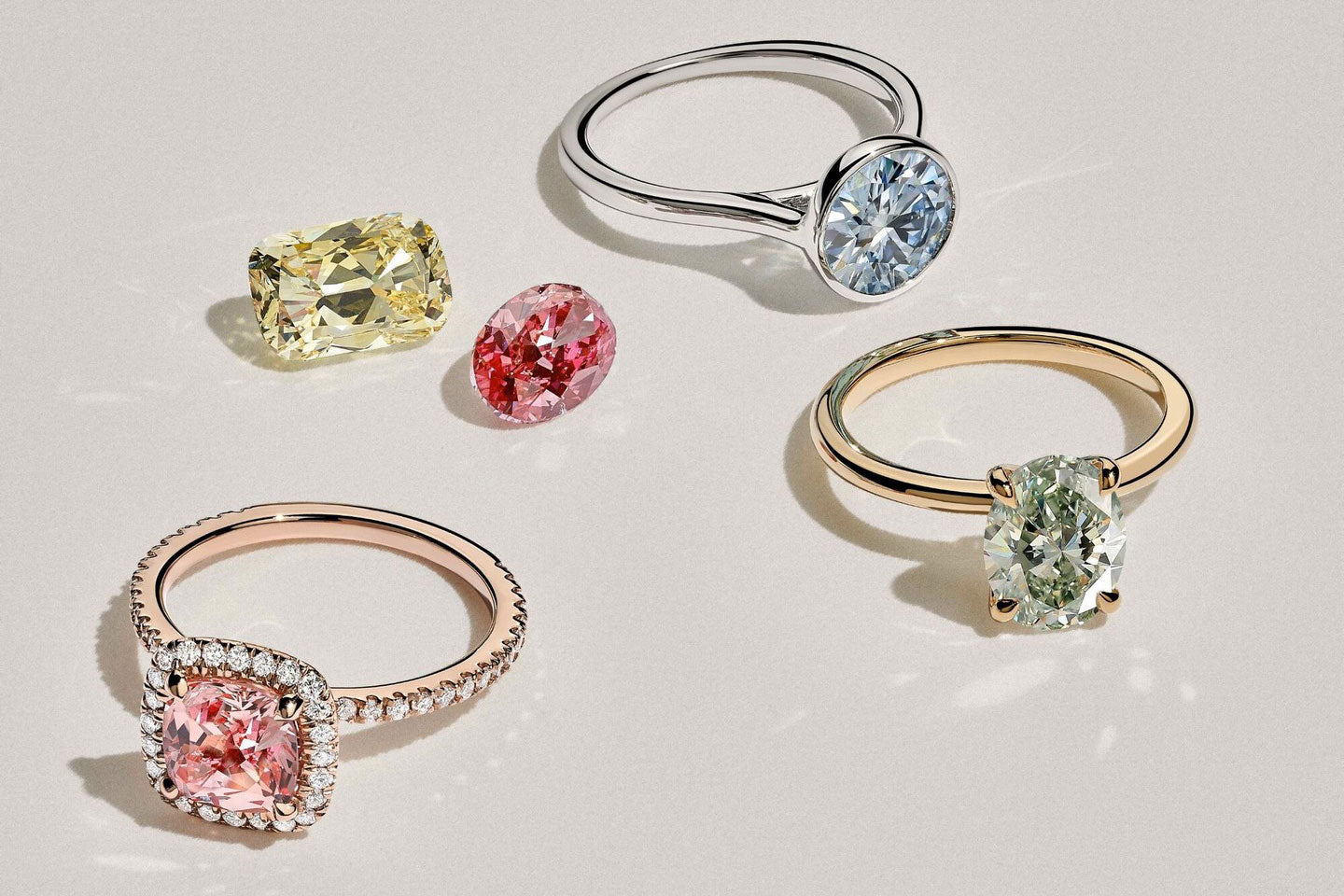
Diamond Color
Diamonds have long been a symbol of love, luxury, and status, and understanding the factors that influence their beauty and value is essential for anyone considering a diamond purchase.
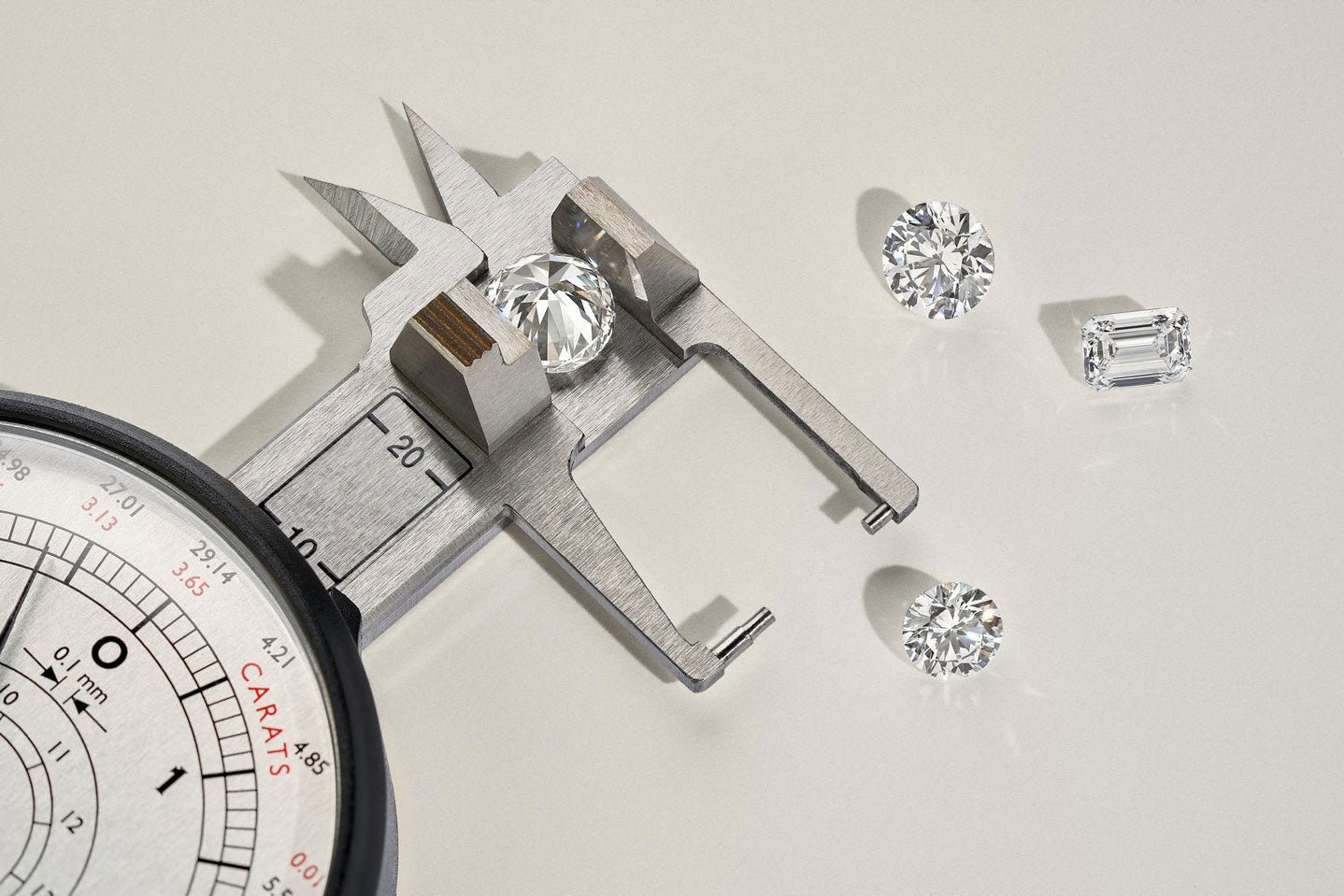
Diamond Carat
A deep dive into how much is a moissanite ring by carat size, factors affecting its value, and tips for selecting the right size for your style and budget.

